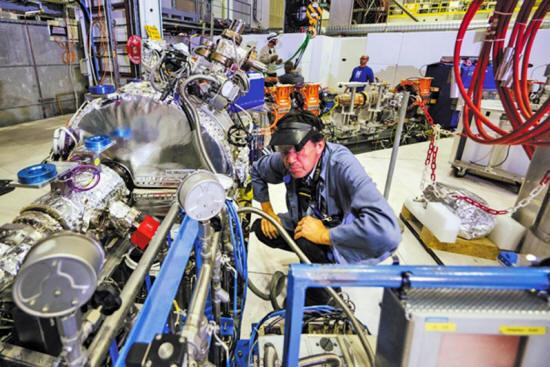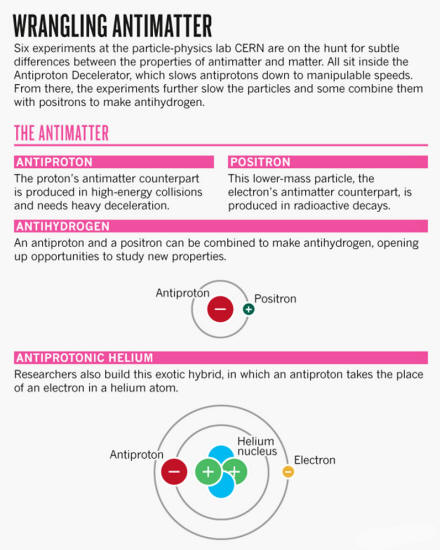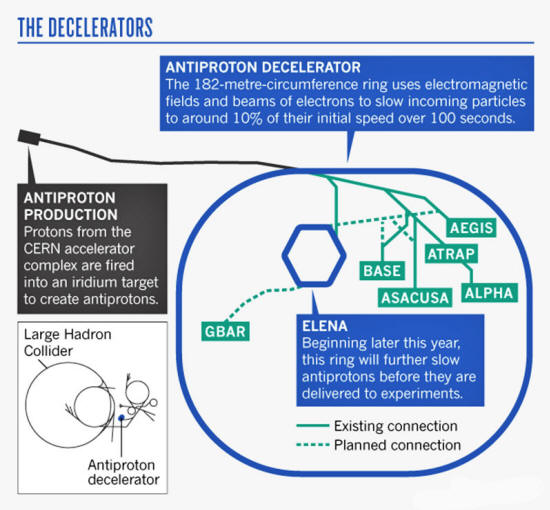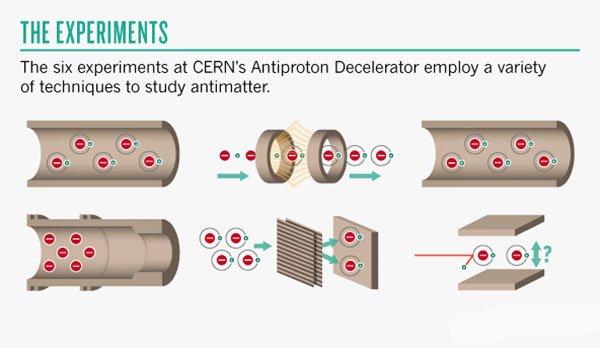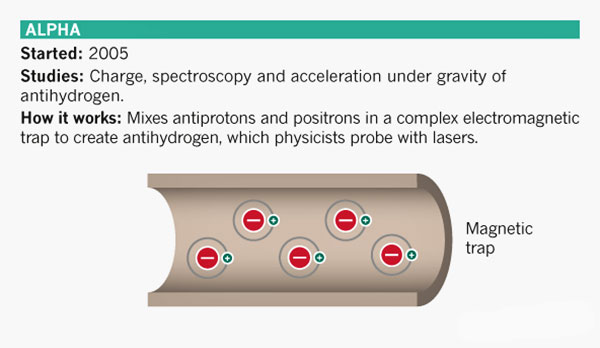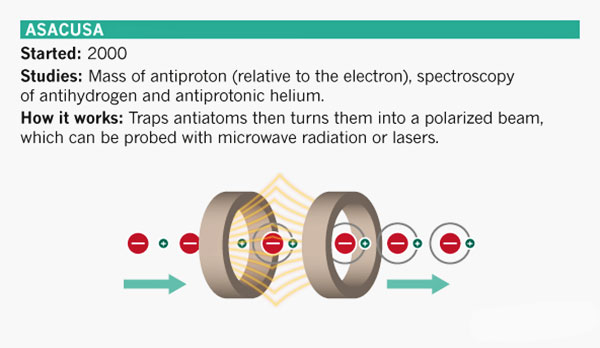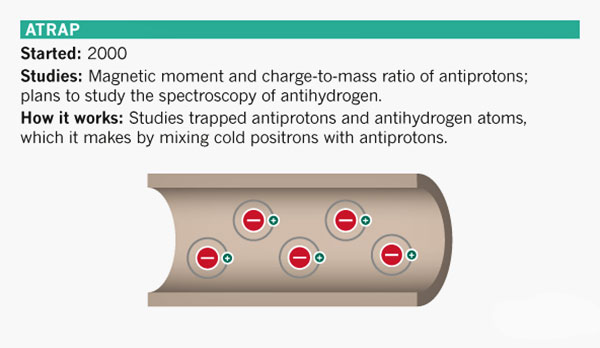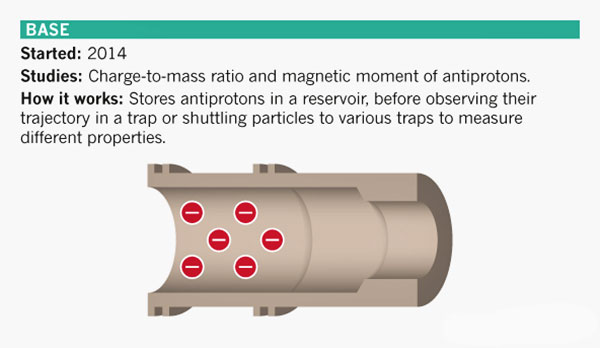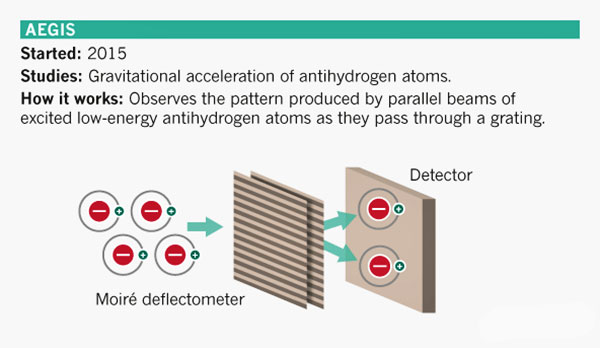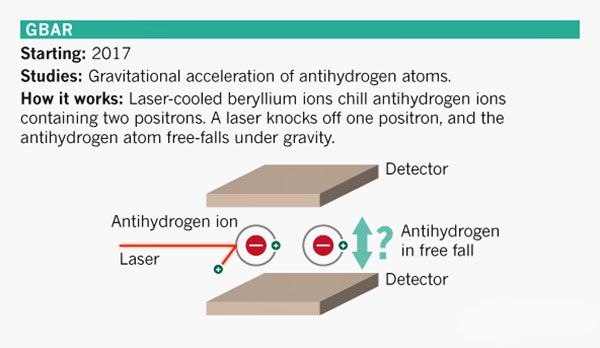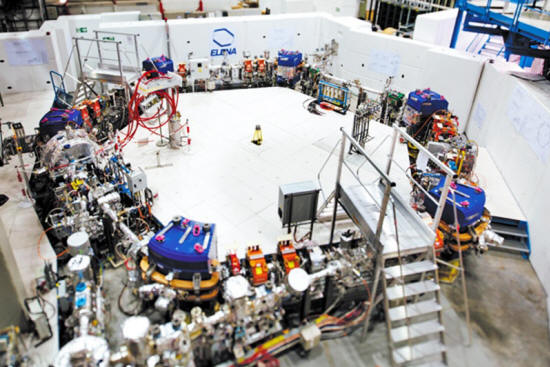|
hosts the only usable source of antiprotons, the proton's antimatter counterpart. Maximilien Brice/CERN
In the shadow of the Large Hadron Collider, six teams are competing to answer
one of the Universe's deepest
existential questions.
They sit just meters apart. In places, they are literally on top of one another: the metallic beam of one crisscrosses another like a shopping-centre escalator, its multitonne concrete support hanging ominously overhead.
Michael Doser and his competitors have little choice but to get cozy.
CERN, Europe's particle-physics laboratory near Geneva, Switzerland, boasts the world's only source of antiprotons - particles that seem identical to protons in every way except for their opposite charge and spin.
The lab's Antiproton Decelerator is a ring, 182 meters around, that feeds from the same accelerators as the lab's bigger and more famous sibling, the Large Hadron Collider (LHC).
Antiprotons enter the machine travelling close to the speed of light. As the name implies, the decelerator slows the particles down, providing a stream of antiprotons from which experiments must take turns to sip.
All this must be done
carefully; upon meeting matter, the antiparticles vanish in a puff
of energy.
The past few years have seen rapid advances:
Jeffrey Hangst, who leads the experiment known as ALPHA, says that in principle at least, his team can now do with antihydrogen anything others do with hydrogen.
The experiments have a lot riding on them: even a slight difference between the properties of matter and antimatter could explain why anything exists at all.
As far as physicists know, matter and antimatter should have been created in equal amounts in the early Universe and so blasted each other into oblivion.
But that didn't happen, and the origin of this fundamental
imbalance remains one of the biggest mysteries in physics.
But the six experiments, the latest in a line of investigations that began at CERN more than 30 years ago, are attracting attention as the LHC continues to draw a blank in its hunt for particles that could explain the antimatter paradox.
Moreover, the teams'
rapid advances in manipulating antimatter have earned them a major
upgrade to the facility's antiproton factory - a cutting-edge
decelerator that will start operation by the end of this year and
eventually enable experiments to work with up to 100 times more
particles (see 'The decelerators').
But CERN's antimatter wranglers are motivated by the thrill of opening a new window on the Universe.
There's no guarantee that antimatter will yield a major discovery.
But,
Dirac realized that there had
to be both a positive and a negative solution to his equation. He
later interpreted this mathematical quirk as suggestive of the
existence of an anti-electron, now called a positron, and theorized
that antimatter equivalents should exist for every particle.
Physicists soon realized that positrons were routinely produced in collisions:
By the 1950s, researchers had begun to exploit this energy-to-particle conversion to produce antiprotons.
But it took
decades to find a way to make enough of them to capture and study.
One motivation was the tantalizing idea that antiprotons and
positrons could be paired to make antihydrogen, which could then be
compared with the well-studied hydrogen atom (see 'Wrangling
antimatter').
But the higher-mass antiproton is another story.
Antiprotons can be made by slamming
protons into a dense metal, but they emerge from such collisions
moving too fast to be held by an electromagnetic trap.
CERN's first dedicated attempt to decelerate and store
antimatter began in 1982, with the Low Energy Antiproton Ring
(LEAR). In 1995, the year before LEAR was slated to be shut down, a
team used antiprotons from the facility to produce the first antihydrogen atoms.
2
Similar to its predecessor, it tames antiparticles, first by focusing them using magnets and then by slowing them using strong electric fields. Beams of electrons also exchange heat with the antiprotons, cooling but not touching them because the particle types are both negatively charged and so repel each other.
The overall process slows the antiprotons to one-tenth
of the speed of light. That is still too fast to work with, so each
of the six experiments uses techniques to further slow and trap the
antiprotons.
By the time Hangst's ALPHA experiment, for example, has slowed its antiprotons enough to pair them with positrons and create antihydrogen, just 30 of the particles remain, the rest having escaped, been annihilated or been discarded because they are too fast or in the wrong condition to study.
Experimenting with such tiny numbers of antiatoms is a real pain, says Hangst:
But for the moment,
CERN has the monopoly on producing antiprotons slow enough to study.
Each has its own way of working with antiprotons, and although some do unique experiments, they often compete to measure the same properties and independently corroborate each other's values (see 'The experiments').
A weekly coordination meeting ensures that each experiment knows when its neighbors' magnet will be running, so as not to ruin sensitive measurements.
But despite the close proximity, teams usually find out about breakthroughs made by their neighbors by reading about them in a paper.
BASE holds the particles in a Penning trap, a complex array of electric fields (which pin particles vertically) and magnetic fields (which make them orbit in a circle). The team can store antiprotons for more than a year, and has used the orbits of antiprotons in the trap to determine the particle's charge-to-mass ratio with record precision. 3
The group also uses a complex method to reveal the antiproton's magnetic moment 4 - akin to its intrinsic magnetism.
The measurement involves switching individual particles rapidly between two separate traps and detecting changes caused by minuscule shifts in an oscillating microwave field.
Mastering the technique has become a passion for collaboration leader Stefan Ulmer, a physicist at RIKEN in Wako, Japan.
Source: CERN
Because it has a neutral charge, it is immune to electric fields, and so nearly impossible to control. Experiments must exploit the antiatoms' weak magnetic properties, restraining the particles with a 'magnetic bottle'.
For the bottle to work, the magnetic fields inside must vary enormously over a tiny distance, changing by 1 tesla - the strength of a car-lifting scrapyard magnet - over just 1 millimeter.
Even so, the antihydrogen
atoms must have a temperature of less than 0.5 kelvin, or they will
escape.
The major breakthrough came almost a decade after that, when the teams learnt to trap the antiatoms for minutes at a stretch. 6
They have since measured properties such as charge and mass and used laser light to probe energy levels. 7
On page 66, ALPHA reports
its latest advance: the most precise measurement yet of
antihydrogen's hyperfine structure, the tiny internal energy shifts
caused by interactions between its antiproton and positron. 8
He leads the ASACUSA experiment, which uses lasers to study antiatoms in flight, free from the disruptive forces of traps.
Last year, the team made a precise measurement of the ratio of antiproton mass to electron mass, using exotic helium atoms in which an antiproton takes the place of an electron. 9
Like other measurements so far, it showed no difference between matter and antimatter.
But each result is a more stringent test of whether matter and antimatter really are exact mirror images.
It would mean the violation of a principle called charge, parity and time reversal (CPT) symmetry. According to this principle, a mirror-image Universe that is filled with antimatter and in which time runs backwards will have the same laws of physics as our own.
CPT symmetry is the
backbone of theories such as relativity and quantum field theory.
Breaking it would, in a way, break physics. In fact, only exotic
theories predict that the antimatter experiments will find anything
at all.
CERN theorist Urs Wiedemann seems to confirm that.
He says that the experiments' ability to manipulate antimatter is "mind-boggling" and that such tests of theory are essential, but,
Still, the LHC has fared little better in solving the antimatter mystery.
Experiments dating back to the 1960s have shown that some physical processes, such as the decay of exotic kaon particles into more familiar ones, have tiny biases in favor of producing matter.
LHC experiments have been hunting more such biases, and even a raft of as-yet-undiscovered particles whose behavior in the early Universe could have accounted for the huge matter-antimatter imbalance that remains.
There has been good reason to suspect such particles exist: they were predicted by super-symmetry, a theory that was proposed to tie up some troubling loose ends in particle physics.
But no such particles have turned up in eight years of searching.
Now, the simplest, most elegant versions of super-symmetry - the ones that made the idea appealing in the first place - have been largely ruled out.
is set
to start slowing the particles down for study this year.
Physicists generally expect antimatter to fall just like matter.
But some fringe theories predict that it has 'negative mass' - it would be repelled by, rather than attracted to, matter. Antimatter with this property might account for the effects of dark energy and dark matter, the identities of which are still unknown.
But most mainstream theorists say such a Universe would be inherently unstable.
Even the tiniest thermal
fluctuations will mask the signal of a falling atom. And only
neutral particles such as antihydrogen can be used, because even
distant sources of electromagnetic fields can expose charged
particles to forces bigger than gravity.
But two other experiments - Doser's AEGIS and the antimatter facility's newest member, GBAR - are hot on the team's heels.
Both use laser-cooling techniques to boost precision, which will enable them to pick up subtler differences between the acceleration of antimatter and matter than ALPHA currently can.
AEGIS will measure the bend of a horizontal beam of antihydrogen, whereas GBAR will let its antiatoms free-fall for 20 centimeters.
Both aim to bring the
antiatoms' temperature down to a few thousandths of a degree above
absolute zero, allowing measurements of gravitational acceleration
as sensitive as 1 part in 100, and have plans to go even further.
Eventually, ELENA will supply particles to all of the experiments, nearly simultaneously.
The antiprotons will be
slower by a factor of seven and arrive in sharper beams. Because
they'll be more efficiently cooled at early stages, experiments
should be able to trap more of the particles.
And the groups are looking outwards, for ways in which their technologies could aid other areas of research.
The GBAR team, for
example, is working on a portable trap to carry antiprotons to a
CERN
experiment called ISOLDE, where they can be used to map the
neutrons in unstable radioactive atoms.
|


